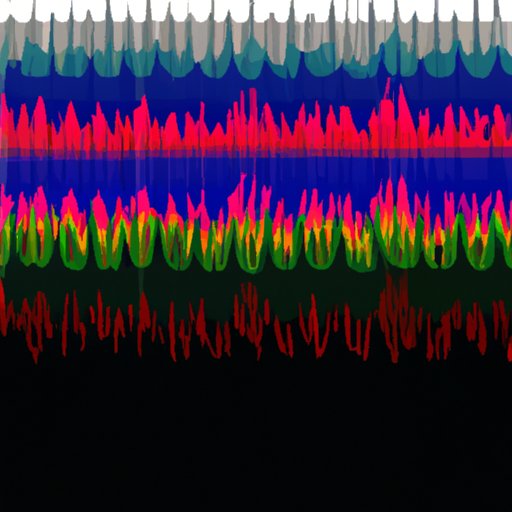Introduction
Sound is a common phenomenon that we experience in our everyday lives, from the sound of birds chirping to the sound of music playing. But have you ever wondered how sound waves travel? In this article, we will explore the physics behind how sound waves travel, examine different types of sound waves, explain the impact of frequency and wavelength on sound, and look at the benefits of controlling sound waves.

Exploring the Physics of How Sound Travels
To understand how sound waves travel, it is important to know what a sound wave is. A sound wave is a type of energy that is created when an object vibrates. The vibrations cause the air particles around it to move back and forth, creating a pressure wave that can be heard as sound. This wave then travels away from the source, carrying sound energy with it.
So how do sound waves travel? When the object vibrates, it causes the air particles around it to move back and forth in a repeating pattern, which creates a pressure wave that moves outward in all directions. As the pressure wave moves through the air, the air molecules push and pull on each other, transferring energy from one molecule to the next. This transfers the sound energy outward in a radial direction, like ripples in a pond.
There are several factors that can affect the way sound waves travel. These include the medium through which the sound is traveling (such as air, water, or solid objects), the temperature of the medium, and the density of the medium. All of these factors can affect the speed and intensity of the sound wave.
Examining Different Types of Sound Waves
There are two main types of sound waves: longitudinal waves and transverse waves. Longitudinal waves are also known as compression waves, because they cause the air molecules to compress and expand as the wave passes through them. Transverse waves, on the other hand, cause the air molecules to move side-to-side as the wave passes through them.
When sound waves reach a boundary between two different media, such as air and water, they can undergo reflection and refraction. Reflection occurs when the wave bounces off the boundary and returns to its original direction. Refraction occurs when the wave bends as it passes through the boundary and changes direction.

The Impact of Frequency and Wavelength on Sound
Frequency is a measure of how often a sound wave oscillates over a given period of time. It is measured in hertz (Hz), which is the number of cycles per second. Higher frequency sounds have higher pitch, while lower frequency sounds have lower pitch. Wavelength is the distance between two successive peaks or troughs of a sound wave. It is measured in meters (m). Longer wavelengths have lower pitch, while shorter wavelengths have higher pitch.
The frequency and wavelength of a sound wave determine its characteristics, such as pitch, loudness, and timbre. For example, higher frequency sounds are usually perceived as louder than lower frequency sounds, and longer wavelength sounds usually have a lower pitch than shorter wavelength sounds.

Exploring the Benefits of Controlling Sound Waves
Controlling sound waves can have many benefits. Acoustic insulation is a process in which sound waves are absorbed or dampened so that they don’t travel far from their source. This can be used to reduce noise pollution from industrial areas or to prevent sound from travelling too far in residential areas. It can also be used to improve the sound quality of recordings or live performances.
Another benefit of controlling sound waves is that it can help reduce reverberation. Reverberation is when sound waves bounce off hard surfaces and create a “echoing” effect. This can be reduced by adding absorbent materials to the surfaces, which will absorb the sound waves and prevent them from bouncing back.
Conclusion
In conclusion, sound waves travel by causing the air particles around them to move back and forth in a repeating pattern, creating a pressure wave that moves outward in all directions. There are two main types of sound waves: longitudinal and transverse waves. The frequency and wavelength of a sound wave determine its characteristics, such as pitch, loudness, and timbre. And finally, controlling sound waves can have many benefits, such as reducing noise pollution and improving sound quality.
(Note: Is this article not meeting your expectations? Do you have knowledge or insights to share? Unlock new opportunities and expand your reach by joining our authors team. Click Registration to join us and share your expertise with our readers.)
